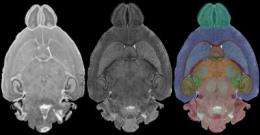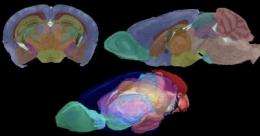Mouse brain seen in sharpest detail ever

The most detailed magnetic resonance images ever obtained of a mammalian brain are now available to researchers in a free, online atlas of an ultra-high-resolution mouse brain, thanks to work at the Duke Center for In Vivo Microscopy.
In a typical clinical MRI scan, each pixel in the image represents a cube of tissue, called a voxel, which is typically 1x1x3 millimeters. "The atlas images, however, are more than 300,000 times higher resolution than an MRI scan, with voxels that are 20 micrometers on a side," said G. Allan Johnson, Ph.D., who heads the Duke Center for In Vivo Microscopy and is Charles E. Putman Distinguished Professor of Radiology.
The interactive images in the atlas will allow researchers worldwide to evaluate the brain from all angles and assess and share their mouse studies against this reference brain in genetics, toxicology and drug discovery.
The brain atlas' detail reaches a resolution of 21 microns. An article detailing the creation of the atlas was published as the cover story in the November issue of NeuroImage journal.

The atlas used three different magnetic resonance microscopy protocols of the intact brain followed by conventional histology to highlight different structures in the reference brain. The brains were scanned using an MR system operating at a magnetic field more than 6 times higher than is routinely used in the clinic. The images were acquired on fixed tissues, with the brain in the cranium to avoid the distortion that occurs when tissues are thinly sliced for conventional histology.
The new Waxholm Space brain can be digitally sliced from any plane or angle, so that researchers can precisely visualize any regions in the brain, along any axis without loss of spatial resolution. (Waxholm is the Swedish town where the early concepts gelled for this atlas.)
"Researchers can take the reference brain apart and put it back together, because we have the 3-D data set intact, and any section will have the same excellent resolution," said Johnson, who is also a professor of biomedical engineering and physics at Duke. "It eliminates the Humpty Dumpty problem that researchers used to face when they made 3-D measurements of brain structures."

For example, a geneticist might want to alter a mouse's genotype in an experiment and learn what happens when the animal becomes highly responsive to fear challenges. "It would be interesting to see if the amygdala, (a brain center related to emotional arousal), is really smaller or larger in the animal," Johnson said. "However, if you do conventional histology, the animal brain shrinks when it is dried or prepared in alcohol, sometimes by about 40 percent. Because of variability, that would make it challenging to measure. This atlas provides a reference to measure against."
The team was also able to digitally segment 37 unique brain structures using the three different data acquisition strategies.
Scientists obtained images of brains from eight mice of the most frequently used strain of laboratory mice (C57BL), aged 66-78 days old. They registered the images together and created both an average and a probabilistic brain for reference. The average and probabilistic brains provide quantitative measure of variability. "It was truly remarkable how alike these structures were from brain to brain," he said.
All of the data is available on the web: www.civm.duhs.duke.edu/neuro201001.
As new data is gathered from other sources, researchers will be able to register it to the same coordinate system, which will promote data sharing, Johnson said. For example the Duke group has recently added data – also at the highest resolution yet attained – that allows definition of fiber tracts connecting different parts of the brain. Investigators at the Allen Brain Institute are now using the MR data to provide 3-D location for their extensive gene expression studies (http://mouse.brain-map.org).














